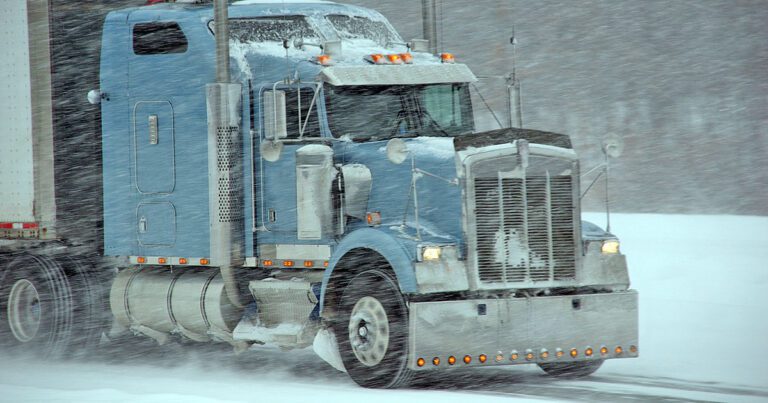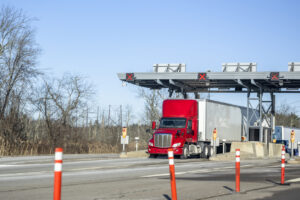AVON, Ohio – Daylight hours are shorter, and temperatures are dropping across the U.S. and Canada, signaling the season where commercial vehicle drivers are increasingly likely to encounter slushy, snowy and icy road conditions.
Bendix Commercial Vehicle Systems is offering tips to help drivers better understand how technology can assist them in being safer on the roads during rough conditions.
“During our ride-and-drive safety technology demonstrations, two questions frequently pop up,” said Fred Andersky, director of demos, sales and service training at Bendix. “The first is, ‘What can I expect from collision mitigation on a slick road?’ and the second is, ‘Could an automatic brake application cause me to lose control?’ Conveniently, the answers are found in the inclusion of full-stability technology as a building block of collision mitigation.”
Understanding collision mitigation technologies
Systems are built upon full-stability control, which has been required on most new Class 7 and 8 air-braked tractors in the U.S. since 2017. Full-stability technologies — generally known in the industry as electronic stability control — are designed to help drivers mitigate rollovers. They’re also engineered to potentially help a driver in some loss-of-control, or some loss-of-vehicle-traction, conditions that can be experienced during wintry weather.
“Just like any safety technology, full stability is there to assist the driver – the driver is always in control of the vehicle at all times,” Andersky said. “And it is important to remember that the system has limits: You can drive too fast and negate its benefit. But by building the collision mitigation technology on top of stability control — which is itself built on the antilock braking system — we’re helping both drivers and the collision mitigation system keep control when brakes are applied.”
Collision mitigation systems may help drivers avoid forward crash situations by reducing the throttle and/or applying the brakes when the system detects a potentially threatening forward collision. The difference is that instead of a driver physically stepping on and off the pedals to engage and disengage the brakes and throttle, a collision mitigation system may deliver the interventions using electronics in the braking system.
Using input gathered by radar, camera and system sensors, a collision mitigation system’s electronic control unit continuously assesses the vehicle’s situation. If the system determines a forward collision is imminent, then it sends signals to the brake controller, which may reduce the throttle and/or apply the brakes.
Prior to cutting the throttle and braking, collision mitigation technology may deliver in-cab alerts as the gap between the truck and a forward vehicle closes. It may also provide an alert before intervening.
Like a driver, the collision mitigation system may need to brake whether the road is slick or not.
It’s important to keep this point in mind: Safety technologies complement safe driving practices. No commercial vehicle safety technology replaces a skilled, alert driver exercising safe driving techniques and proactive, comprehensive driver training.
In terms of road conditions, collision mitigation systems are subject to the same laws of physics as a driver: What happens with the applications of brakes on a slick surface — a surface with the potential loss of vehicle traction? The vehicle slows and eventually stops. If skidding starts to occur, then the ABS and stability control systems may intervene to help the driver keep control in some situations.
The same is true for a collision mitigation system. The obvious difference is that when either the driver or the collision mitigation technology is braking on a slick surface instead of a dry surface, the vehicle requires more time and distance to come to a stop.
Real-world examples
The Bendix team spends a portion of every winter at the Keweenaw Research Center in Michigan’s Upper Peninsula, where there is no shortage of brutal winter conditions for putting vehicles and safety systems to the test.
Joining the engineers and other personnel on site, Andersky — who holds a Class A CDL and regularly drives at Bendix demonstrations — had the opportunity to get behind the wheel to put a truck through normal demo maneuvers, but on a surface of slick, packed snow. He drove a 6×4 tractor with a loaded trailer, air disc brakes, and a gross vehicle combination weight of 65,000 pounds, and performed tests involving both a stationary and slow-moving forward vehicle.
“The first thing to understand is that the collision mitigation system must detect the situation ahead, then perform calculations to determine if or when alerts or automatic braking is needed,” Andy Pilkington, Bendix product group director of ADAS/HAD, said. “The faster the truck approaches the forward vehicle (whether it is stationary or moving), the more difficult it is to detect and the less time the system has to react. For demonstration purposes, Fred ran two common traffic scenarios to better illustrate system reaction.”
First, approaching a stationary car at a moderate speed, the vehicle’s collision mitigation system detected the situation and intervened as designed: By alerting the driver, cutting the throttle and applying the brakes to assist. However, because of the approach speed and slick surface, the vehicle slid — just as if the driver had applied the brakes.
“Sometimes there is not enough time or friction with the road surface to provide any alert or sufficient braking force to mitigate impact with the forward vehicle,” Pilkington said. “In other situations, the truck can partially decelerate and may still impact the forward vehicle with a lesser speed. And in yet another set of circumstances, there is sufficient friction with the road surface and time to detect the situation to prevent impact altogether.”
Andersky said that the driver must stay alert and deal with potentially threatening situations themselves and that collision mitigation systems are driver assistance, not driver replacement.
The next maneuver, at a higher speed, simulates the common situation of a slow-moving vehicle in a driver’s lane of travel, with the tractor-trailer coming up fast on a slower-moving vehicle. As before, after the system detected the situation, it alerted and applied the brakes – and in both cases, while the vehicle slowed, the speed reduction alone did not avoid the forward vehicle: Andersky needed to swerve to prevent the collision.
“The same possibilities detailed in the first maneuver exist here as well,” Pilkington said. “Sometimes only an alert is given or limited braking is applied, or in other situations, maximum braking occurs; the response is contingent on the exact situation, the closure rate with the forward vehicle, and how much time the system has to detect the situation and react.”
“In other words, the system reacted as it was designed and allowed me the opportunity to take action,” Andersky said. “Not all that surprising. Whether the forward vehicle is moving or stationary, bringing a loaded tractor-trailer to a stop requires more time and distance on a slick surface.”
Science and reality of the road
The coefficient of friction represents the amount of friction between two surfaces — the lower it is, the more easily the two surfaces will slide. Compared to a dry asphalt or concrete surface, the coefficient of friction of truck tires on hard-packed snow or ice is up to 87% less. Combine this situation with the mass and speed of a combination vehicle – 80,000 lbs. and 55 miles per hour, for instance – and it roughly compares to the stopping distance on various surfaces, bringing the science into the real world.
Bendix testing shows that the truck that takes 335 feet to stop on dry pavement, for example, will likely take 466 feet to stop on a wet road, 965 feet to stop on packed snow, and 1,625 feet – more than a quarter mile – to stop on ice. Nearly triple the stopping distance between snow and dry road, and almost five times as long to stop on ice as a dry surface. This means both the driver and the system need to be aware of what is happening down the road to react in time.
“This is the perfect illustration of why driver alerts are so critical,” Pilkington said. “Giving the drivers time to react before a system intervenes helps capitalize on their abilities to see farther and also to steer — something most of today’s collision mitigation technologies don’t do.”
Pilkington said it also shows the value of the collision mitigation system on a slick surface: Beyond the interventions, depending on the situation, the alerts can help re-engage the driver to brake or take other action to avoid a hazard. And if the driver intervenes to steer around the situation, then full stability can possibly help them keep control of the vehicle.
As to any potential loss of control caused by system-generated collision mitigation braking, it is no more of an issue than a driver applying brakes on the same surface, especially since the full-stability system is already integrated to help maintain control.
“Ultimately, safe, alert drivers are the single most important factor to help mitigate collisions on slick roads,” Andersky said. “They have advantages over technology – sight and steering – and they’re trained to recognize the crucial factors in increasing following distance to create reaction time when the weather gets bad.”
The Trucker News Staff produces engaging content for not only TheTrucker.com, but also The Trucker Newspaper, which has been serving the trucking industry for more than 30 years. With a focus on drivers, the Trucker News Staff aims to provide relevant, objective content pertaining to the trucking segment of the transportation industry. The Trucker News Staff is based in Little Rock, Arkansas.















